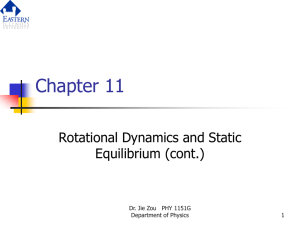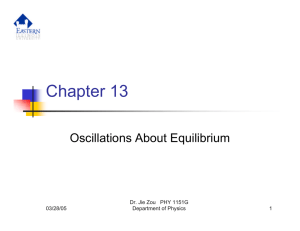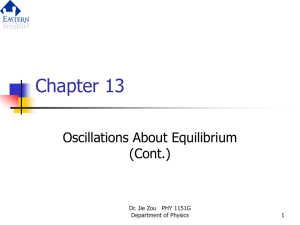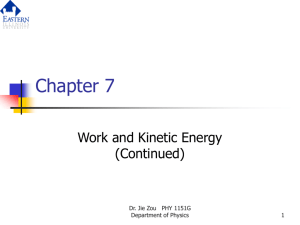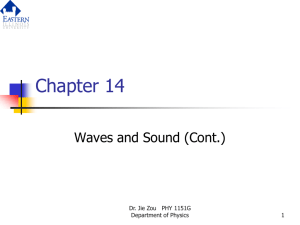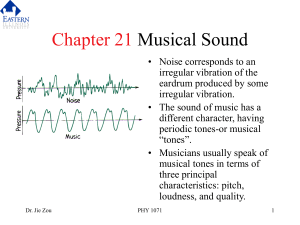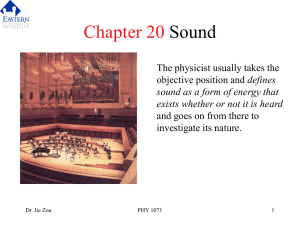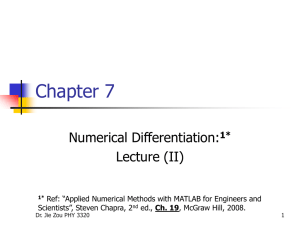Periodic motion
advertisement
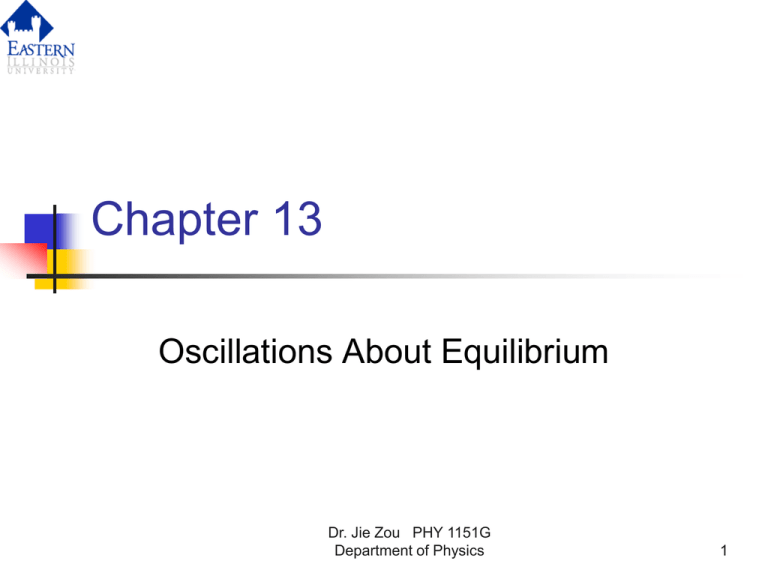
Chapter 13 Oscillations About Equilibrium Dr. Jie Zou PHY 1151G Department of Physics 1 Outline Oscillations Periodic motions Basic cause for oscillations Period and frequency Simple harmonic motions Classical example: A mass attached to a spring Position as a function of time for a simple harmonic motion Period of a mass on a spring Dr. Jie Zou PHY 1151G Department of Physics 2 Oscillations Oscillations: When systems are displaced from equilibrium, it often results in oscillations back and forth from one side of the equilibrium position to the other. Basic cause of oscillations: When an object is displaced from a position of stable equilibrium it experiences a restoring force that is directed back toward the equilibrium position. Dr. Jie Zou PHY 1151G Department of Physics 3 Periodic Motion Periodic motion: A motion that repeats itself over and over is referred to as periodic motion. Definition of period, T : time required for one cycle (one oscillation) of a periodic motion. The trace of an SI unit: second or s. electrocardiogram Definition of frequency, f : the (ECG or EKG). number of oscillations per unit of time. f = 1/T. SI unit: per second = 1/s = Hz. Dr. Jie Zou PHY 1151G Department of Physics 4 Example: Periodic motion If the processing speed of a personal computer is 1.80 GHz, how much time is required for one processing cycle? A tennis ball is hit back and forth between two players warming up for a match. If it takes 2.31 s for the ball to go from one player to the other, what are the period and frequency of the tennis ball’s motion? Dr. Jie Zou PHY 1151G Department of Physics 5 Simple harmonic motion A classical example of simple harmonic motion: The mass-spring system. Key feature of a massspring system: A spring exerts a restoring force that is proportional to the displacement from equilibrium, F = - kx. Dr. Jie Zou PHY 1151G Department of Physics 6 Position versus time for simple harmonic motion Position versus time in simple harmonic motion: x Acos2 t T Here we suppose that the cart is released at t = 0 from rest at x = A . Amplitude, A : it represents the maximum displacement of the cart on either side of equilibrium. Period, T : the cart’s motion repeats with a period T. Dr. Jie Zou PHY 1151G Department of Physics 7 Example An air-track cart attached to a spring completes one oscillation every 2.4 s. At t = 0 the cart is released from rest at a distance of 0.10 m from its equilibrium position. What is the position of the cart at (a) 0.30 s, (b) 0.60 s, (c) 2.7 s, and (d) 3.0 s? Dr. Jie Zou PHY 1151G Department of Physics 8 Period of a mass on a spring m A horizontal spring: T 2 k Unstretched at their equilibrium position. Here m is the mass (kg), and k is the force constant of the spring (N/m), and T is the period (s). The period, T, increases with the mass and decreases with the spring’s force constant. The period, T, is independent of the amplitude, A . Dr. Jie Zou PHY 1151G Department of Physics 9 A vertical spring A vertical spring is in equilibrium at y=-y0. At this equilibrium position, the spring stretches by an amount y0 given by ky0 = mg or y0 = mg/k A mass on a vertical spring oscillates about the equilibrium point y = -y0. m The period is also T 2 k Dr. Jie Zou PHY 1151G Department of Physics 10 Example When a 0.420-kg mass is attached to a spring, it oscillates with a period of 0.350 s. If, instead, a different mass, m2, is attached to the same spring, it oscillates with a period of 0.700 s. Find (a) the force constant of the spring and (b) the mass m2. Real world physics: the relationship between the mass and period is used by NASA to measure the mass of astronauts in orbit - The Body Mass Measurement Device (BMMD) Dr. Jie Zou PHY 1151G Department of Physics 11 Homework See online homework on www.masteringphysics.com Dr. Jie Zou PHY 1151G Department of Physics 12
